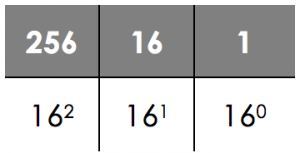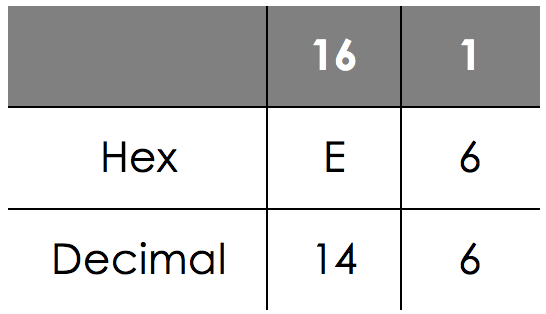Number Bases - Hexadecimal
Introduction to Hexadecimal
In Number Bases - Binary, we saw that there are different number base systems, and we looked at how we can convert between binary (base 2) and decimal (base 10). One thing that you may have very quickly worked out, is that converting between binary and decimal isn’t very nice… but writing numbers using binary is long and tedious! This is where hexadecimal comes in.
Hexadecimal is a base 16 number system. This means that the column headers now go up in powers of 16.
In computer science though, we only ever really use 2 digits.
Hexadecimal is used to make binary numbers easier to read for humans, avoid mistakes and allow us to quickly convert into binary. It is important to remember though that computers don’t understand hexadecimal any more than they can understand decimal. It’s just a way for humans to represent numbers.
In hexadecimal, because we now have 16 characters to contend with, we have to add a few to our repertoire. In hexadecimal, the numbers 10-15 are represented using the characters A-F, so the number B in hexadecimal would be 11 in decimal.
Hexadecimal and Binary
Converting between hexadecimal and binary is simple as all we need to worry about is converting each nibble at a time.
Hexadecimal and Binary
Converting between hexadecimal and binary is simple as all we need to worry about is converting each nibble at a time.
Binary to Hexadecimal
To convert a binary number to hexadecimal you need to follow these steps:
- Split the binary string up into nibbles (remember a nibble = 4 bits)
- Work out the decimal value for each nibble
- Convert the decimal value into it’s hex equivalent
- String together the hex values
Example - Convert 1010 1100 to hexadecimal
First we convert the number into nibbles:
Then, looking at each nibble, we convert that into its corresponding hexadecimal digit:
So 1010 1100 in Hex is AC.
Hexadecimal and Decimal
This is very similar to what we have just seen but the other way around:
- Calculate the decimal value of each hex digit.
- Write this as a binary number.
- Concatenate (join) the numbers together.
Example - Convert 4F to binary
So 4F in binary is 0100 1111.
Hexadecimal and Decimal
Since we only really have 2 hexadecimal digits to consider, this is slightly more straightforward than converting binary numbers to decimal, but uses the same principles.
Hexadecimal to Decimal
- Write the place headings above the hexadecimal digits.
- If there are letters, convert them to their decimal equivalent.
- Multiply the value by the place heading.
- Add these values together
Example - E6 in Decimal
So the decimal value would be:
(14 x 16) + (6 x 1) = 230
Decimal to Hexadecimal
- Work out how many 16s there are in the number
- Write this number under the 16s column
- Write the remainder under the 1s column
- Covert these to hexadecimal digits (if applicable)
Example - 75 in Hexadecimal
So 75 in decimal is 4B in hexadecimal.
- Convert these binary numbers to hexadecimal:0011 0101
- 35
- Convert these binary numbers to hexadecimal:1100 0011
- C3
- Convert these binary numbers to hexadecimal:1101 1111
- DF
- Convert these hexadecimal numbers to binary:24
- 00100100
- Convert these hexadecimal numbers to binary:A6
- 10100110
- Convert these hexadecimal numbers to binary:CA
- 11001010
- Convert these hexadecimal numbers to decimal:17
- 23
- Convert these hexadecimal numbers to decimal:9A
- 154
- Convert these hexadecimal numbers to decimal:F5
- 245
- Convert these decimal numbers to hexadecimal:72
- 48
- Convert these decimal numbers to hexadecimal:162
- A2
- Convert these decimal numbers to hexadecimal:241
- F1





